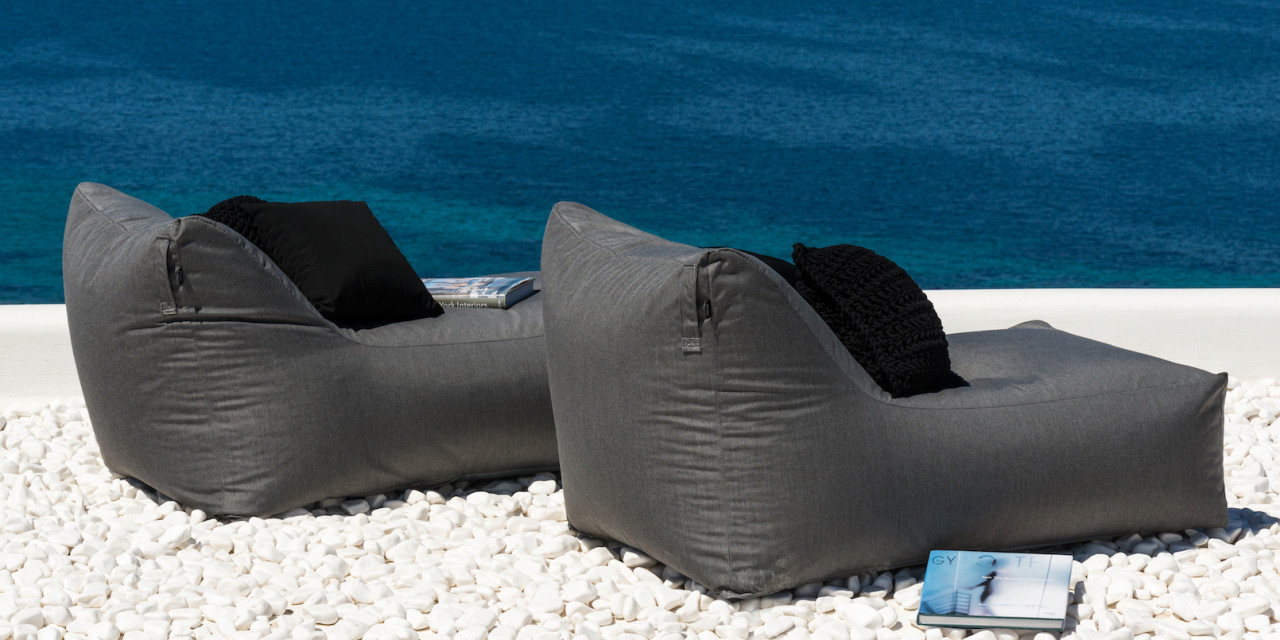At ANAEI, we are aware that part of our Outdoor & Spa product portfolio is classified as beanbags due to the fact that it is lounge or seating furniture with polystyrene bead filling. It is a fact that the first and original products of this type were simple cloth sacks filled with polystyrene beads, as they are still manufactured and sold by different suppliers, so this classification is actually correct.
Yet, we don't think that the term beanbag is appropriate for our products, as our products are anything but a simple bag of fabric. On the contrary, they are seating and lying pieces of furniture of high quality and beautiful shapes and designs with a high level of lounge comfort. Thus, we prefer the alternative names of loungers & poufs for our outdoor & spa furniture filled with polystyrene beads, which are referred to as seat loungers, chaise longue loungers or daybed loungers as well as poufs, depending on the purpose of use & the size.
However, if we have to stick to the common term ‘beanbag’, for which there are now numerous manufacturers and suppliers on the market, is every beanbag the same? And how are they different from each other? What are the criteria for distinguishing the individual products, also with regard to their price?
Production: is the beanbag made by hand or industrially? The industrial production of several thousand pieces of beanbags is obviously much cheaper than the manual production of individual pieces and thus has a direct impact on the price.
Origin: where is the beanbag made? Industrial mass production in Asia, especially in China or other low-wage countries, is much cheaper compared to an industrial production in Europe or a mostly manual production in Europe and that has a direct impact on the price.
Product type: what kind of beanbag is it? A simple fabric or plastic bag is much easier and cheaper to produce than a beanbag with the shape of actual seating or lying furniture, which is also reflected in the price.
Product size: how big is the beanbag? This has to do with transportation, the transport options and the associated transport costs. In logistics and shipping, girth measurements are used. If the beanbag is a simple beanbag that can be easily folded or compressed into a smaller package and can be transported within a certain girth, shipping using numerous transport service providers is relatively inexpensive. However, if the beanbag is in the form of a piece of seating or lying furniture and is actually not a simple beanbag, but a piece of furniture that requires a certain packaging size outside the regular girth, transport is almost only possible via forwarding and individual transport agents, which is particularly important in times like this and greatly affects the transport costs and thus also the price.
Execution: what is the execution of the beanbag? Does the cover of the beanbag have a zipper to remove the cover? Is the cover washable? Does the beanbag have an extra inner sleeve for easy refilling of polystyrene beads? Does the inner shell have several chambers so that the seating or lying comfort is guaranteed in the long term? The type of design has a direct impact on the way of use of a beanbag and thus on the sustainability and price of the beanbag.
Use: for what use is the beanbag made? If a beanbag is only made for indoor use, it can be made with any standard fabric or leather used in standard furniture manufacturing. If the beanbag is also made for outdoor or spa use, special materials are required, high-quality and particularly durable fabrics or artificial leather for outdoor & spa use, weatherproof yarns for processing, weatherproof zippers and weatherproof inner protective covers made of PVC, PU or similar.
Quality of the materials used: what is the quality of the materials used? The feel of the materials used is particularly important for beanbags, which are supposed to be essentially comfortable and adaptable to the shape of the user hence act as a hug. Cheap materials with a plastic feel may not necessarily contribute to comfort, but of course they are cheaper to manufacture. If the beanbag can also be used outside, the beanbag must be made of special high-quality and water-repellent fabrics or artificial leather for outdoor use, which should ideally be coated on the outside and laminated on the inside, but still have a natural fabric or leather feel. For outdoor use, the materials must have a high level of lightfastness or a high lightfastness factor so that the coatings retain their color in the sun for as long as possible and do not fade. The quality of the inner protective cover used, if any, should increase the weather resistance of the beanbag. The quality of the polystyrene beads used determines how quickly they may shrink or deteriorate and need to be exchanged, and thus also the lifespan of the beanbag.
Brand: how well known is the brand of the beanbag? The brand awareness of a product is almost always directly related to a manufacturer's marketing expenses, for which of course they have to be compensated. Thus, the price of a beanbag is not always in line with the previously mentioned price criteria such as manufacture, regionality, type & size, use & quality of the beanbag, but is often distorted by brand awareness and expenditure in marketing activities.
Every beanbag is not the same. A beanbag of industrial mass production in China or similar low-cost manufacturing countries, delivered in large numbers to hardware stores and wholesalers without high standards of comfort or longevity, is therefore of course disproportionately cheaper than beanbags that are handmade in Europe with a claim to design, quality, comfort & durability & consequently sustainability.






